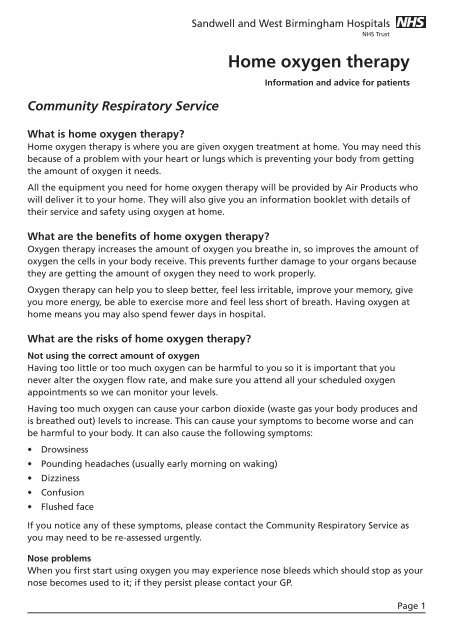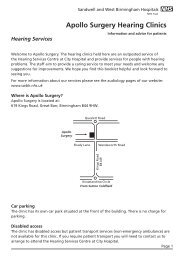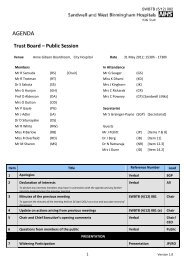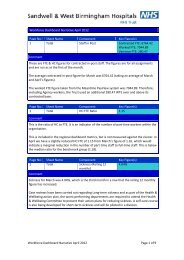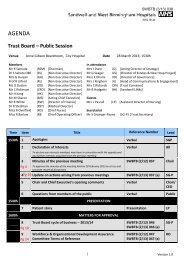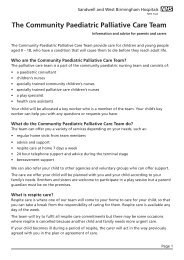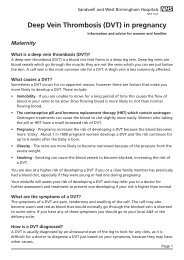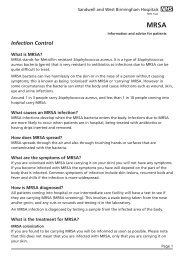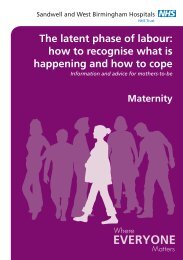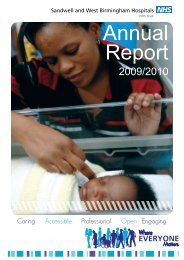Home oxygen therapy - Sandwell & West Birmingham Hospitals
Home oxygen therapy - Sandwell & West Birmingham Hospitals
Home oxygen therapy - Sandwell & West Birmingham Hospitals
Create successful ePaper yourself
Turn your PDF publications into a flip-book with our unique Google optimized e-Paper software.
<strong>Home</strong> <strong>oxygen</strong> <strong>therapy</strong><br />
Information and advice for patients<br />
Community Respiratory Service<br />
What is home <strong>oxygen</strong> <strong>therapy</strong>?<br />
<strong>Home</strong> <strong>oxygen</strong> <strong>therapy</strong> is where you are given <strong>oxygen</strong> treatment at home. You may need this<br />
because of a problem with your heart or lungs which is preventing your body from getting<br />
the amount of <strong>oxygen</strong> it needs.<br />
All the equipment you need for home <strong>oxygen</strong> <strong>therapy</strong> will be provided by Air Products who<br />
will deliver it to your home. They will also give you an information booklet with details of<br />
their service and safety using <strong>oxygen</strong> at home.<br />
What are the benefits of home <strong>oxygen</strong> <strong>therapy</strong>?<br />
Oxygen <strong>therapy</strong> increases the amount of <strong>oxygen</strong> you breathe in, so improves the amount of<br />
<strong>oxygen</strong> the cells in your body receive. This prevents further damage to your organs because<br />
they are getting the amount of <strong>oxygen</strong> they need to work properly.<br />
Oxygen <strong>therapy</strong> can help you to sleep better, feel less irritable, improve your memory, give<br />
you more energy, be able to exercise more and feel less short of breath. Having <strong>oxygen</strong> at<br />
home means you may also spend fewer days in hospital.<br />
What are the risks of home <strong>oxygen</strong> <strong>therapy</strong>?<br />
Not using the correct amount of <strong>oxygen</strong><br />
Having too little or too much <strong>oxygen</strong> can be harmful to you so it is important that you<br />
never alter the <strong>oxygen</strong> flow rate, and make sure you attend all your scheduled <strong>oxygen</strong><br />
appointments so we can monitor your levels.<br />
Having too much <strong>oxygen</strong> can cause your carbon dioxide (waste gas your body produces and<br />
is breathed out) levels to increase. This can cause your symptoms to become worse and can<br />
be harmful to your body. It can also cause the following symptoms:<br />
• Drowsiness<br />
• Pounding headaches (usually early morning on waking)<br />
• Dizziness<br />
• Confusion<br />
• Flushed face<br />
If you notice any of these symptoms, please contact the Community Respiratory Service as<br />
you may need to be re-assessed urgently.<br />
Nose problems<br />
When you first start using <strong>oxygen</strong> you may experience nose bleeds which should stop as your<br />
nose becomes used to it; if they persist please contact your GP.<br />
Page 1
<strong>Home</strong> <strong>oxygen</strong> <strong>therapy</strong><br />
Information and advice for patients<br />
Community Respiratory Service<br />
You may also experience some nasal congestion which can be treated with medicines from<br />
your pharmacy, and a dry or sore nose which can be relieved by applying a water-based<br />
gel such as K-Y Jelly inside the nose; don’t use substances such as Vaseline which contain<br />
petroleum.<br />
Sore ears<br />
The tubing that holds the mask or nasal prongs in place can sometimes cause your ears to<br />
become sore. To prevent or relieve this wrap soft material such as cotton wool around the<br />
part of the tubing that sits on your ears.<br />
Fire<br />
Using <strong>oxygen</strong> can increase the risk of fire so it is very important that you do not smoke, let<br />
anyone else smoke or have an open flame nearby when you are using <strong>oxygen</strong> <strong>therapy</strong>. Air<br />
Products will give you an information leaflet with more detail about using <strong>oxygen</strong> safely at<br />
home. You are also advised to book a free home fire safety check with your local fire service<br />
who can also provide you with free smoke alarms if needed (contact number on back page).<br />
Are there any alternative treatments?<br />
Your doctor/nurse have assessed you and decided that home <strong>oxygen</strong> <strong>therapy</strong> is the most<br />
suitable treatment for you. There may be alternative treatment options for you but this will<br />
depend on your condition and you can discuss this with your doctor.<br />
What are the risks of declining home <strong>oxygen</strong> <strong>therapy</strong>?<br />
If you decide not to use <strong>oxygen</strong> at home, over time you may develop problems with some of<br />
your organs because they cannot get the amount of <strong>oxygen</strong> they need to work properly.<br />
The symptoms you have been experiencing will not improve and you may also develop other<br />
symptoms such as decreased ability to exercise, shortness of breath, fatigue and/or occasional<br />
disorientation or memory loss.<br />
How is <strong>oxygen</strong> <strong>therapy</strong> given?<br />
You will be advised on how many hours you need to use the <strong>oxygen</strong> for by the clinician you<br />
see in <strong>oxygen</strong> clinic. The type of <strong>oxygen</strong>, amount of <strong>oxygen</strong> you need and how long to use it<br />
for, is determined by either a special blood test and/or a walk assessment. You can be given<br />
<strong>oxygen</strong> <strong>therapy</strong> either through an <strong>oxygen</strong> concentrator, an ambulatory <strong>oxygen</strong> cylinder or<br />
both.<br />
Oxygen concentrator<br />
An <strong>oxygen</strong> concentrator is an electrically operated device that draws in room air, separates<br />
the <strong>oxygen</strong> from the other gases in the air and filters any bacteria out of the air. It then<br />
Page 2
<strong>Home</strong> <strong>oxygen</strong> <strong>therapy</strong><br />
Information and advice for patients<br />
Community Respiratory Service<br />
delivers the <strong>oxygen</strong> through tubing to a mask or prongs in your nose.<br />
Using an <strong>oxygen</strong> concentrator should not stop you from moving about your house. You<br />
can have up to 50 feet of tubing, which should be as much as you need to move about<br />
your home freely. Otherwise you can have the tubing plumbed in around the home, which<br />
reduces the risk of tripping over the tubing. If you would like these adjustments to your<br />
tubing, please contact your <strong>oxygen</strong> supplier.<br />
You will be reimbursed for the cost of the electricity used to power your <strong>oxygen</strong> concentrator<br />
(Air Products will give you information on this) and will also be given a back-up <strong>oxygen</strong><br />
cylinder to use in case of a problem with your electricity supply.<br />
Ambulatory device<br />
An ambulatory (mobile) <strong>oxygen</strong> device may be a small cylinder, portable <strong>oxygen</strong> machine or<br />
liquid <strong>oxygen</strong> device which is for use during activities that make you the most breathless and<br />
tired, not when you are resting. You will have had a walk test at the <strong>oxygen</strong> clinic to see how<br />
much <strong>oxygen</strong> you need when walking.<br />
Air Products will supply the equipment you need for this and you should contact them when<br />
the <strong>oxygen</strong> cylinder needs changing.<br />
How long will I need home <strong>oxygen</strong> <strong>therapy</strong> for?<br />
If you are having <strong>oxygen</strong> <strong>therapy</strong> because you have a long-term condition you will need to<br />
use the <strong>oxygen</strong> permanently. If you are having <strong>oxygen</strong> for a short-term illness you may not<br />
need it once you have recovered. You will be given follow-up appointments to check that the<br />
amount of <strong>oxygen</strong> you are receiving is correct.<br />
How do I know if I am receiving enough <strong>oxygen</strong>?<br />
The only way to know that you are receiving enough <strong>oxygen</strong> is by having a specialist <strong>oxygen</strong><br />
assessment. You will not be able to know any other way because breathlessness is not related<br />
to how good your <strong>oxygen</strong> levels are; you can be severely breathless and have good <strong>oxygen</strong><br />
levels or you mildly breathless with low <strong>oxygen</strong> levels.<br />
If you think you are not getting enough <strong>oxygen</strong> please contact the Community Respiratory<br />
Service to discuss this.<br />
Going on holiday<br />
If you are going on holiday in this country, you can order a supply of <strong>oxygen</strong> to take with<br />
you by contacting Air Products. You will need to tell them your holiday dates and the<br />
address, telephone number and contact name for the place you will be staying. Your <strong>oxygen</strong><br />
will be delivered to where you are staying on the day you arrive and will be taken away on<br />
the day you leave.<br />
Page 3
<strong>Home</strong> <strong>oxygen</strong> <strong>therapy</strong><br />
Information and advice for patients<br />
Community Respiratory Service<br />
If you are going abroad, you can organise a supply of <strong>oxygen</strong> this by contacting Air Products<br />
who will advise you of what to do, however please be aware that travelling abroad with<br />
<strong>oxygen</strong> is not a free service.<br />
Contact details<br />
Community Respiratory Service<br />
0121 612 2007<br />
Monday – Friday, 8am – 8pm<br />
Saturday & Sunday, 8.30am – 4.30pm<br />
Air Products (<strong>oxygen</strong> supplier)<br />
0800 373 580<br />
Monday – Friday, 8am – 5pm<br />
<strong>West</strong> Midlands Fire Service<br />
0800 389 5525<br />
Sources used for the information in this leaflet<br />
• British Thoracic Society Emergency Oxygen Guideline Group, ‘Guideline for emergency<br />
<strong>oxygen</strong> use in adult patients’, October 2008<br />
• Air Products, ‘A guide to the <strong>Home</strong> Oxygen Service’, 2011<br />
If you would like to suggest any amendments or improvements to this leaflet please contact the<br />
communications department on 0121 507 5420 or email: swb-tr.swbh-gm-patient-information@nhs.net<br />
A Teaching Trust of The University of <strong>Birmingham</strong><br />
Incorporating City, <strong>Sandwell</strong> and Rowley Regis <strong>Hospitals</strong><br />
© <strong>Sandwell</strong> and <strong>West</strong> <strong>Birmingham</strong> <strong>Hospitals</strong> NHS Trust<br />
ML3729<br />
Issue Date: June 2012<br />
Review Date: June 2014<br />
Page 4


